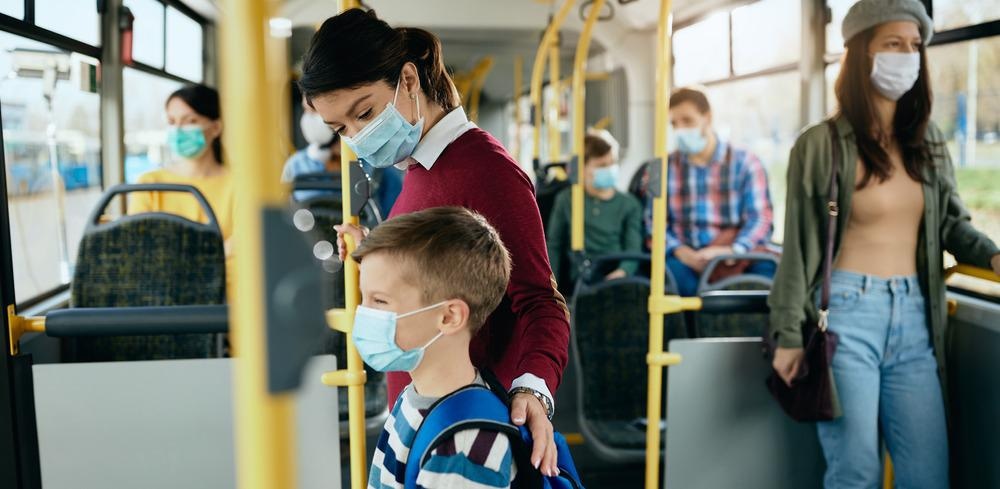
In a preprint study, researchers have revealed that passive sensors on public transport could help track and reduce COVID-19 cases. Image Credit: Drazen Zigic/Shutterstock.com
The University of Washington researchers who developed the system believe that it shows promise as a method of tracking the geographical transmission of the virus by gathering data in a passive manner, over time, without the need to install expensive new equipment on transport systems.
Tracking Local COVID-19 Outbreaks
As of June 2021, the number of confirmed cases of COVID-19 infection exceeded 172 million and the number of those who have died from the virus stood at 3.7 million.
Since the virus was first identified in China in 2019, scientists worldwide have strived to understand more about how the virus is transmitted to prevent new cases and contain the virus.
Studies rapidly revealed that the SARS-CoV-2 virus (responsible for the COVID-19 pandemic) is transmitted primarily via airborne droplets expelled by those infected, hence the measures brought in worldwide to prevent face-to-face interactions and reduce the risk of these airborne droplets entering public spaces.
At the beginning of the pandemic, much emphasis was put on limiting the transmission of the disease via contact with contaminated surfaces. However, recent evidence has shown that this is not the main route to infection. Therefore, tracking the viral presence of the virus in the air, particularly in shared public spaces such as transportation, is vital to monitoring the spread of the disease and managing potential new outbreaks.
A team at the University of Washington designed and tested a novel method to identify the presence of SARS-CoV-2 RNA in the air filters already installed on public buses. The results of the team’s tests demonstrate the potential to leverage existing equipment to detect the virus and gather rich data on regional outbreaks.
Establishing a Novel Method of SARS-CoV-2 Tracking
To establish a sensitive and reliable method of viral detection, the team used a combination of viral lysis, RNA extraction, and RNA detection via reverse transcription-quantitative polymerase chain reaction (RT-qPCR). Previously, this combination of techniques had not been proven in previous literature.
While previous studies had demonstrated the success of extracting viral species from air filters installed in buildings, the new method is unique in that it presents a passive strategy for surveilling local SARS-CoV-2 levels in public transport.
In collecting data from bus filters and analyzing it for the presence of the SARS-CoV-2 virus, the team showed how regional outbreaks could be monitored in a cheap and scalable manner.
The Future of Monitoring Contagious Diseases
The University of Washington team’s research will potentially shape how contagious diseases are tracked in the future. The method has applications for tracking regional outbreaks of COVID-19 and other airborne viruses.
The techniques offer an affordable strategy that can easily be implemented in cities across the globe given its reliance on infrastructure and equipment that already exists.
The impact of the novel method may be the more timely implementation of measures to curb the spread of the virus, keeping ahead transmission peaks before they occur. The method may be more vital in scenarios when cases in the community are generally low overall, helping to alert officials when transmission may peak in certain areas. In the future, we could see this method being adopted on a large scale as part of a growing arsenal of preventative strategies.
*Important notice
medRxiv publishes preliminary scientific reports that are not peer-reviewed and, therefore, should not be regarded as conclusive, guide clinical practice/health-related behavior, or treated as established information.
References and Further Reading
Covid map: Coronavirus cases, deaths, vaccinations by country. BBC News. Available at: https://www.bbc.co.uk/news/world-51235105
Hoffman, J., Hirano, M., Panpradist, N., Breda, J., Ruth, P., Xu, Y., Lester, J., Nguyen, B., Ceze, L. and Patel, S., 2021. Passively Sensing SARS-CoV-2 RNA in Public Transit Buses. medRxiv https://www.medrxiv.org/content/10.1101/2021.06.02.21258184v1.full-text
Horve, P., Dietz, L., Fretz, M., Constant, D., Wilkes, A., Townes, J., Martindale, R., Messer, W. and Van Den Wymelenberg, K., 2020. Identification of SARS-CoV-2 RNA in Healthcare Heating, Ventilation, and Air Conditioning Units. medRxiv https://www.medrxiv.org/content/10.1101/2020.06.26.20141085v1
Disclaimer: The views expressed here are those of the author expressed in their private capacity and do not necessarily represent the views of AZoM.com Limited T/A AZoNetwork the owner and operator of this website. This disclaimer forms part of the Terms and conditions of use of this website.